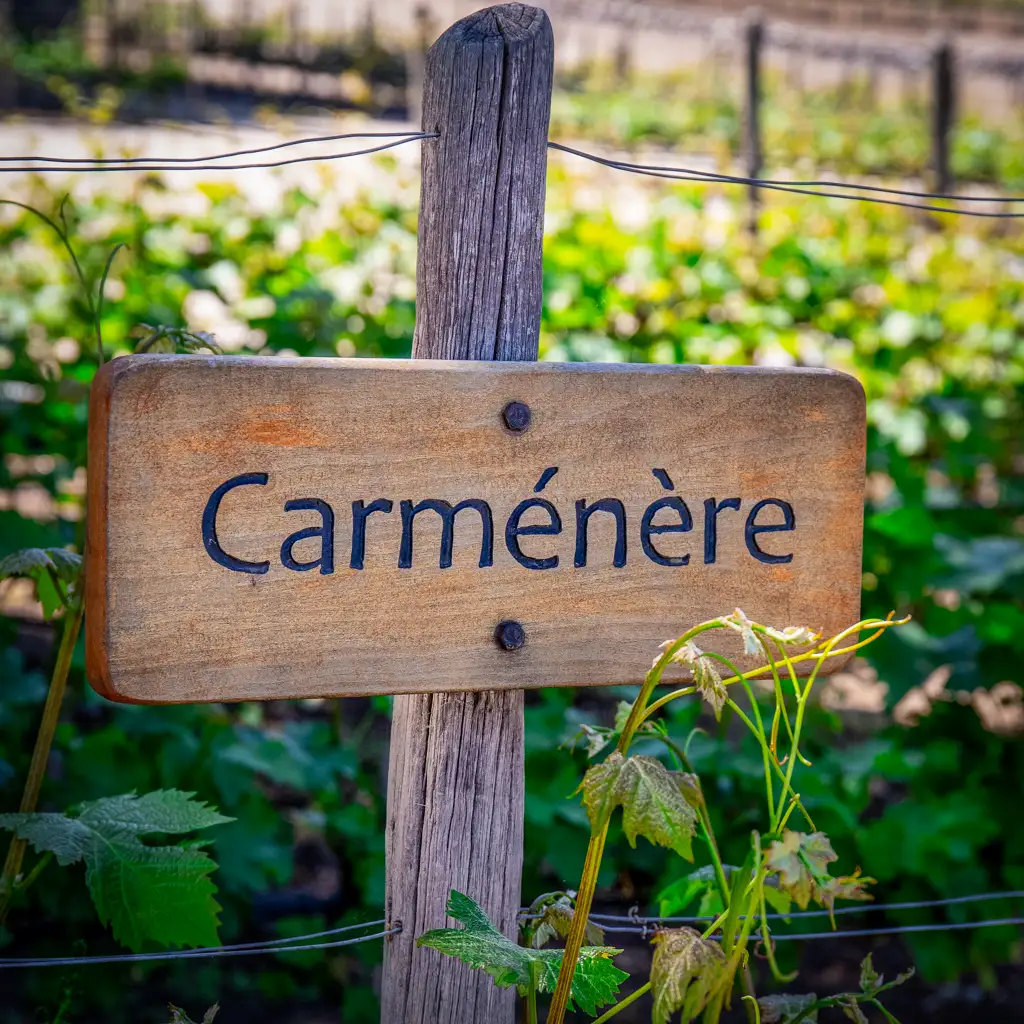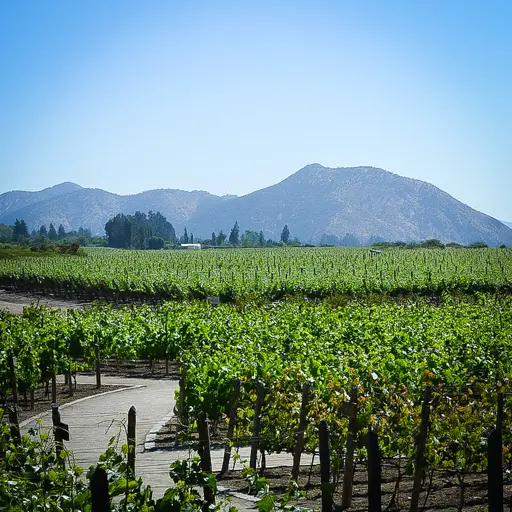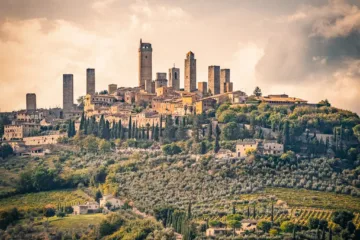
Despite only having 2.7% of the world’s vineyard surface area, Chile is a wine powerhouse and the largest wine-producing country in South America. Chile ranks sixth after Italy, France, Spain, Australia and the USA.
With nearly twenty million inhabitants, the narrow country between the Andes Mountain Range and the Pacific Ocean is an avid wine consumer. However, most of the wine produced in the country is enjoyed in foreign markets. Carménère is the country’s flagship red wine grape, the third most produced after Cabernet Sauvignon and Merlot. Nonetheless, Carménère is special for another reason: you won’t find it almost anywhere else. This article is about what you need to know about Chilean Carménère.
The History of Carménère in Chile
Carménère is a red grape from Bordeaux. It is in the same family as Cabernet Sauvignon, Cabernet Franc and Merlot. In fact, it was widely planted in Bordeaux until the phylloxera outbreak of the late 1800s. When it was time to replant the vineyards, grape growers chose Cabernet Sauvignon and Merlot over Carménère and other local grapes varieties, such as Malbec, favoring the most resistant varietals. After a few years, there was no trace of the grape in its ancestral home. Carménère was thought to be extinct.
Little did grape growers and wine enthusiasts know that immigrants had planted some Carménère on the other side of the world, in Chile, along with several other French varietals. As the South American country made a name for itself as a reputable wine producer, grape growers noticed that not all of their Merlot grapes behaved in the same way. Patches of late-ripening grapes looked nothing like Merlot, despite being labeled as such. In 1994, ampelographer Jean-Michel Boursiquot proved that these odd grapes were effectively the thought long-lost Carménère. Producers in the country soon made the now-famous grape their flagship varietal; the rest is history.

Terroir and Viticulture

Chile extends 2,653 miles (4,270 km) from the arid Atacama Desert to the cold Antarctic Circle. However, you’ll find most of its vineyards in Central Chile, between the Coastal Mountain Range and the Andes. The climate is cold near the coast and high up in the Andes foothills; these regions are best suited for cold-climate grapes like Pinot Noir and Sauvignon Blanc. The Central Valley, however, excels at producing high-quality Bordelaise varietals, including Cabernet Sauvignon, Merlot and Carménère.
The most prominent Carménère vineyards are in the inland Rapel Valley and its sub-regions, Cachapoal and Colchagua. Others are closer to Santiago, in the Aconcagua Valley, protected by the highest mountain in America, the Aconcagua.
Chile is so secluded and benefit from well aerated vineyards that pests and fungal deseases are not a threat. This means the vines don’t have to be grafted with phylloxera-resistant rootstocks. This also means that growing grapes in Chile orgnanically is relatively easy, as fungal diseases are only a problem in vintages with excessive moisture. Overall, grapevines grow healthy in Chile, as the country has the perfect conditions to grow premium grapes and craft equally superb wines.
Winemaking
As a Bordelaise varietal, it’s not surprising that Carménère is treated like other grapes that are typical of Bordeaux. The grapes are picked late in the season, crushed and fermented traditionally, sometimes in vertical wooden casks. Large wine companies dominate Chile’s wine industry, so most of the wine is produced on a large scale.
Carménère grapes are concentrated, textural and flavorful, so they benefit from extended oak aging. French oak is preferred, but winemakers also experiment with American oak. New oak is more common in high-tier wines, but more subtle approaches are becoming the norm.
Carmenere’s Flavor, Aroma and Personality
A handful of large estates make up most of the Chilean wine industry. Each offers immense wine catalogs, from cheap, everyday wine to collectors’ wines. Carménère is used in both.
Inexpensive Carménère will show red fruit and noticeable vegetal notes on the nose over a rustic and sometimes thin palate. High-end Carménère wines resemble those made with Cabernet Sauvignon; they’re structured, complex, and age well. Expect raspberries and plums with bell pepper notes and hints of oaky vanilla. Compared with Bordeaux wines, Chilean Carménère will always have riper fruit aromas, lower acidity, and more pronounced alcoholic strength.
Carménère pairs well with red meat, notably fatty beefs. It also performs well when served with duck and other birds. Less expensive Carménère is an excellent everyday red wine, while the most refined examples will rise to the occasion, even in fine-dining evenings.

Wines to Try
Montes’ Purple Angel’, Colchagua Valley
Montes Alpha is a revolutionary Chilean winery that has elevated the country’s wine quality while preserving the environment with sustainable practices in the vineyard and cellar. Their Purple Angel is perhaps the best-known monovarietal Carménère out there, and this wine is clearly worth trying.
This one’s made with grapes from the Colchagua Valley, particularly from the sub-region of Apalta, where the poor soils result in concentrated grapes. This deep red wine ages 18 months in new French oak barrels, resulting in an elegant wine with sweet blackberry notes and hints of coffee and chocolate over a structured palate with angular tannins and balancing acidity. Purple Angel is delicious when served with grilled red meat, and it can replace robust Cabernet Sauvignon in any scenario.
Concha y Toro Carmin de Peumo Carmenere, Cachapoal Valley
Concha y Toro is one of the largest estates in Chile. The winery is best known for its affordable wines, but it also produces high-end bottles with fruit sourced from some of the most spectacular sites. Carmin de Peumo comes from the Peumo Vineyard in the Peumo appellation, within the Cachapoal Valley, where the ungrafted pre-phylloxera vines dig deep in the clay soils, ensuring flavorful fruit.
Carmin de Peumo Carménère ages for 15 months in nearly 90% new French oak. The wine takes a while to open, but it releases black fruit aromas with violet undertones when it does. The palate is refined and lengthy, with bold tannins and flavor intensity. This full-bodied red wine is best enjoyed with lamb, game and spicy sauces.
Lapostolle Cuvee Alexandre Apalta Vineyard Carmenere, Apalta
Founded in 1994, Lapostolle is among the most exciting wineries in Chile for its focus on fine wine that has a sense of place. The team behind Lapostolle’s wines genuinely knows the land, specifically Apalta, which has become the source of some of the country’s best wines. Sustainable farming, recycling, water waste management and energy savings are the core values behind the brand; they’re certified sustainable, which is not common in the country.
Cuvee Alexandre is a vibrant Carménère made with grapes from the estate’s vineyards in Apalta. It has 3% Merlot, which helps round up the wine for a seductive experience. Expect ripe plums and blackberries on the nose over a palate with noticeable acidity and smooth, round tannins. The wine ages for 13 months in new French oak and is best paired with red meat and seasoned food.

Follow me on my Social Media
Wine is a gourmet treasure, do not abuse alcohol!
None of this content has been sponsored
I did not receive any gifts or free samples that could be related to this article


